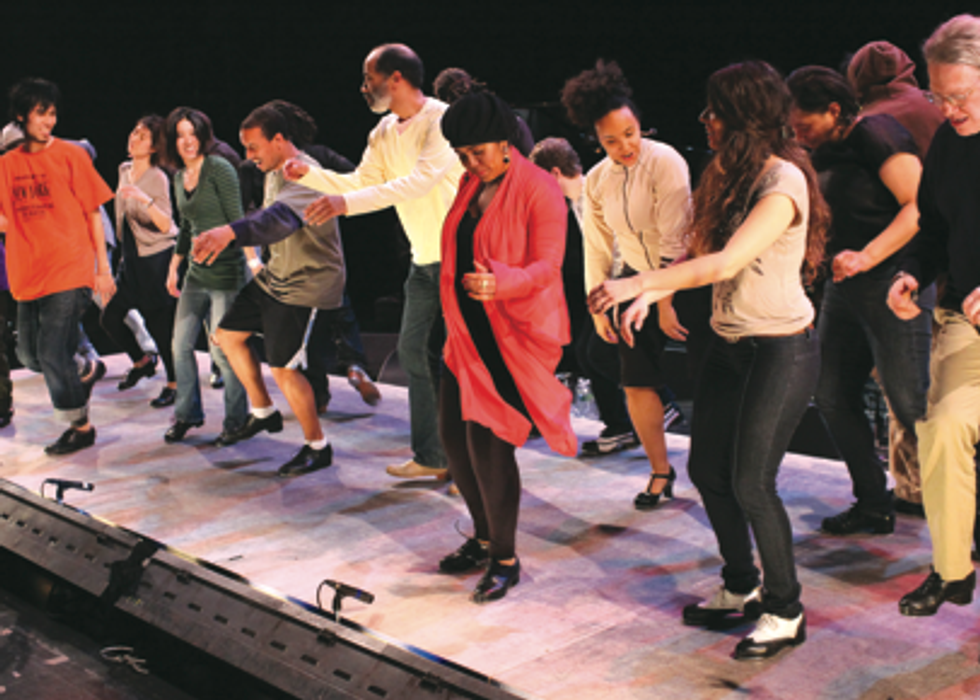The Shim Sham

Dancers at the Shim Sham tap jam at The Kitchen in NYC. Photo by Paula Court.
You’re at a tap show and have been trying to keep your feet still, but the dancer within you is getting antsy. It’s hard to keep from jumping out of your seat—so at the end of the evening, when the emcee invites everyone onstage to do the Shim Sham, you’re ready to go!
Dancers of all ages crowd onstage together. The music starts and everyone sinks into a slight plié. Soon the room echoes with a familiar tap combination: Stomp-brush-step, stomp-brush-step, stomp-brush-ball-change, stomp-brush-step. This pattern repeats two more times and then an 8-count break leads into the Shim Sham’s next section.
The Shim Sham is a short routine that brings together tappers of all skill levels. No one’s too old, too young, too inexperienced or too accomplished to partake. “I know of no other dance that invites and inspires community like the Shim Sham,” says Constance Valis Hill, a tap dancer, choreographer and performance scholar. In fact, the Shim Sham is so important that the tap community has dubbed it the “international hoofers anthem.”
Though it’s decades old, the Shim Sham is still done at all types of tap events, from festivals to memorial services. “The Shim Sham seemed like such a simple dance at first,” says 17-year-old Marcus Franklin, a New York–based tapper. “Then I saw everyone doing it and I realized, wow, this is a powerful piece!” Participating in the Shim Sham connects you to tap’s history. “You become part of the legacy,” says tap dancer and dance preservationist Rusty Frank.
Evolution of the Shim Sham
Like anything passed on from dancer to dancer, the Shim Sham’s history isn’t easy to nail down. Leonard Reed, a tap dancer who performed in the 1920s and ’30s, claimed to have created the Shim Sham. But, according to Frank, Reed didn’t come up with it on his own. At the time, Reed was part of a tap duo with Willie Bryant. Frank says Reed and Bryant created the Shim Sham with the Whitman Sisters, a song-and-dance troupe who directed their own shows and became one of the longest-running and highest-paid acts on the black vaudeville circuit. Frank says that in 1927, Reed and Bryant were performing for the Whitman Sisters, who asked the duo to come up with a finale the entire cast could dance together. Reed and Bryant put together a one-chorus routine featuring four tap sequences popular with chorus girls of the time connected by breaks.
What most now recognize as the classic Shim Sham is that dance, which Reed and Bryant added to their act and originally called the Goofus because of the goofy manner in which they performed it, often to the bouncy tune of “Turkey in the Straw.” After the duo broke up, Reed became the Shim Sham’s preeminent personality. “Reed’s genius was the order he put the steps in and the showmanship he exhibited,” Frank says.
In the 1930s, the Shim Sham became the Shim Sham Shimmy when a quick shoulder shake was added to the choreography. Harold Cromer, a more-than-50-year tap veteran best known as Stumpy from the famous comedy tap team Stump and Stumpy, recalls learning the Shim Sham Shimmy with the chorus girls at the Apollo in NYC. “Over the years, the Shim Sham has mutated into a simple dance,” he says. “But it used to be a sexy dance. That’s what the girls were doing: the Shim Sham Shimmy with frills and heels.” Nonetheless, most people agree that Reed is responsible for the most popular version of the Shim Sham.
The Basic Breakdown
Click here and here to get a detailed Shim Sham lesson with tap dancer Claudia Rahardjanoto.
If you’re at a tap event, you’ll probably see the classic Shim Sham, which is a lot like Reed’s Goofus: A single chorus routine with four counts of eight bars each. According to Valis Hill’s recent book Tap Dancing America, these sections are: the double shuffle, the crossover, the Tack Annie, and the half break (also known as “falling off the log”).
Each section has a set structure, and you’ll recognize most of the steps from tap class. For example, the double shuffle is a simple stomp-brush-step pattern repeated three times followed by a syncopated 8-count break that includes basic tap vocabulary: heel drops, digs and hops.The crossover rocks back and forth between the feet, and then uses digs and heels. The Tack Annie includes stomps followed by spank touches, and the half break features stomps and shuffle ball-changes. The Shim Sham finishes off with another break—or you can repeat the whole thing again!
Don’t get discouraged if you’re at an event and the Shim Sham steps aren’t exactly what you’ve learned. Sometimes people play around with the choreography. “The breaks are one area where people have fun and fiddle around,” Frank says. But the overall structure should be the same, so you’ll be able to keep up with the group.
Follow Along
Even if you haven’t mastered the Shim Sham, don’t let this stop you from participating. It’s the kind of routine you pick up as you go. The more you do it, the more comfortable you’ll feel. Besides, the Shim Sham is about having fun!
L.A.–based freelance writer Brynn Wein Shiovitz is currently pursuing a PhD in UCLA’s Department of World Arts and Cultures. She teaches dance and yoga at various studios throughout the greater L.A. area.




